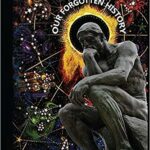
Summary
Transcript
Professor Walter Burkert, a german scholar of greek mythology who taught at the University of Zurich, Switzerland, states that the impact on greek art in this period is evident in imported objects as well by the new techniques and characteristic motifs of artistic imagery, though the prejudices of modern scholars have led them to disregard the overwhelming evidence. He argues that even expert archaeologists, however, sometimes appear to feel uncomfortable about this fact and indeed advise against using the expression the orientalizing period. The foreign element remain subject to a policy of containment. There is hardly a standard textbook that has oriental and greek objects depicted side by side.
Many of the oriental finds in the great greek sanctuaries have long remained and some still remain unpublished. Oriental simply means eastern. And of course, the phoenician influence on ancient Greece cannot be understated, which is blatantly obvious with the adoption by the Greeks of the phoenician script. The Greeks did not begin to use letters for writing until about 700 bc, borrowing their Alphabet with only slight innovations from a letter system that had been used equally by the Hebrews who intermarried with them. The Greeks themselves called their alphabetic letters phoenician, which had supposedly been introduced to them by Cadmus, a phoenician prince and founder of Thebes.
According to greek mythology, Cadmus was the son of the king and queen of Tyre, the phoenician capital, and the brother of Europa, a phoenician princess from where Europe gets its name. Tyre is located just 12 miles from the border of modern Israel, whose flag features the symbol of a star almost as famous as the swastika, both of which were used by the Phoenicians and both predating all abrahamic religions, having their roots in the chaldean mystery schools predating Babylon, belonging to the arian magi of Mesopotamia, or ancient Iran, formerly known as Persia, Iran is a name derived from the word Aryan.
The country was renamed in 1935 by Reza Shah Pahlavi, the iranian king. At the time, the name change was a way to distance the country from its colonial past, eastern perspectives, and to reconnect with its ancient aryan roots, which it shared with Europe, an ancestry well known to the Germans and welcomed by Adolf Hitler, who in 1936 classified Iranians as pureblood Aryans and excluded Iran from Nuremberg laws, declaring Iran a aryan country and even exempting iranian Jews from wearing the yellow Star of David. It was none other than Darius the Great, whose 250 zero year old tomb has etched in stone.
I am Darius the great king, the king of kings, the king of many countries and many people, the king of this expansive land. Persian the son of a persian Aryan, from the aryan race, of course. In Farsi Germany is called Olman, after the Alamani, a confederation of aryan tribes on the upper Rhine river during the first millennium, who are also known as the Suvi or Subi, where we get the name for Sweden from, as well as Swabia as in Neuschwabenland, a territory in Antarctica annexed and renamed by nationalist Germany, which I cover in my prior videos.
Farsi, like English, French or German, is an indo european or aryan language, as the ancient Aryans that rode horses and chariots into India thousands of years ago. Introducing Sanskrit and its caste system, with aryan nobility at the top, also entered Europe, evident not only by linguistics but also by genetics, introducing the blonde, blue eyed phenotype into Europe, as well as lactose tolerance, meaning the inherited ability to digest dairy or milk as an adult. During the Holocene, cattle were domesticated in the Middle east. Yet northern Europeans are among the most lactose tolerant demographics in the world, not to mention with a high degree of blue eyes, blond hair, and a blood factor that is largely immune to HIV.
Speaking to their aryan ancestry and migration from the Caucasus, which is where the term Caucasian comes from. Incidentally, it’s also where Noah allegedly settled after the great Deluge and where, according to icelandic sagas, Odin originated from before migrating with his people north, establishing the swedish royal dynasty, and later becoming deified in myth as a norse or germanic God. These blond, blue eyed Aryans introduced the chocolytic or copper age to the Levant 6500 years ago, influencing canaanite or phoenician culture of Mesopotamia and Chaldea, a term which implies the time predating Babylon, such as the Sumerians and Amorites, and making up the noble priest class, which are historically known as the arian magi.
When speaking of the Aryan Magi, 33rd degree Freemason Albert pike wrote in his book Morals and Dogma, the occult science of the ancient magi was concealed under the shadows of the ancient mysteries it was imperfectly revealed, or rather disfigured by the Gnostics. It is guessed at under the obscurities that cover the pretended crimes of the Templars. And it is found enveloped in enigmas that seem impenetrable in the rights of the highest masonry. In other words, freemasonry, rosicrucianism, gnosticism, hermeticism, philosophy and esoteric alchemy are all based on the original pre lurianic chaldean kabbalah disseminated by Knights Templar, which, according to Pyke, originally stemmed from the Aryan Magi.
According to Helena Blavatsky, the founder of Theosophy, the mysteries of the Jews were identical with those of the pagan Greeks, who took them from the Egyptians, who borrowed them in their turn from the Chaldeans, who got them from the Aryans, the Atlanteans, and so on, far beyond the days of that race. Though Pythagoras was born on the island of Samos, his father was a phoenician from Tyre. Pythagoras had travelled to Egypt, at which point, according to Apelleus in his apology, he was captured by Cambyses, son of Cyrus the Great, during his egyptian invasion and taken back to Babylon along with other prisoners.
In Babylon, Pythagoras was initiated into the highest esoteric mysteries of the Zoroastrians. As british historian Bertrard Russell outlined, from Pythagoras, orphic elements entered into the philosophy of Plato, and from Plato into most later philosophy that was in any degree religious. According to belgian archaeologist and historian Franz Cument, the reality of hellenic borrowings from semitic sources remains nonetheless indisputable. At a distant date, hellas received from the far east a duodecimal or sexy decimal system of measurement, both of time and of objects. The habit of reckoning in terms of 12 hours, which we still use today, is due to the fact that the Ionians borrowed from the Orientals this method of dividing the day.
Besides the acquaintance with early instruments such as the sundial, they owed to the observatories of Mesopotamia the fundamental data of their celestial topography, the ecliptic, the signs of the zodiac, the majority of the planet. Which brings us back to the Greeks, who are known as the Hellenes through their descent from Helen, not to be confused with Helen of Troy, but a male king who along with his siblings, were the offspring of Deucalion, the greek version of Noah, who along with his wife Pyrrha, were the only family to survive the great flood. In classical times, the Greeks recognized four great divisions among themselves that descend from this lineage, each named in honor of their respective ancestors, the Ionians, Dorians, Aeolians, and Achaeans.
The Ionians were descended from Danis and Cadmus, who we have established as the Phoenician, credited with introducing the original Alphabet to the Greeks, and were also identified with the Hyksos, a dynasty of foreign invaders who ruled a northern portion of Egypt, establishing themselves at a town called Abydos, but who were finally expelled by the Egyptians in 1450 BC and eventually settled Palestine. Manetho, an egyptian priest who lived around 250 bc, equated the Hyksos with the Jews of the Exodus. So did the historian Josephus, who also identified the Hyksos with the Hebrews of the Bible, which in egyptian means foreign rulers, which makes sense as they introduced the horse, chariot, and bronze medal to the african continent.
Hecatius of Abdera, a greek historian of the fourth century BC, summed up the expulsion of the Hyksos dynasty. Like this, the natives of the land surmised that unless they removed the foreigners, their troubles would never be resolved at once. Therefore, the aliens were driven from the country, and the most outstanding and active Mongols banded together and, as some say, were cast ashore in Greece and certain other regions. Their leaders were notable men, among them being Danis and Cadmuse. But the greater number were driven into what is now called Judea, which is not far from Egypt and at that time was utterly uninhabited.
The colony was headed by a man called Moses. The Dorians, who were said to have invaded Greece, were also believed to have been of phoenician origin, which some scholars connect to the upheavals brought about by the invasion of the sea people, referred to in egyptian records that I covered in a prior video. The Danins, descended of Danis, are usually identified as one of the twelve tribes of Israelites, the tribe of Dan or Danites. In the Iliad, Homer refers to the Greeks as Achaeans, who are related to the Danins, descendant of Danis, who were believed to be the son of egyptian king Belus, also known as baalje.
Belus is the hellenized or greek form of the semitic word baal, which means lord, a term equated to the phoenician storm God, but is also identified with the greek zeus, the latin or roman Jupiter, and the hindu indrade. The hindu God Indra is considered the main equivalent to Zeus in greek mythology and is the indo european cousin of the german wotan, or norse Odin, who, according to archaeologist Thor Heyerdahl, was a historical person who founded the norwegian swedish royal dynasty migrating north from the Caucasus steppes, the same region that DNA testing concluded. The Brahmin class of India originated from the land classical authors called scythia, which gave rise to the noble aryan lineage that includes Sitartha, Gautama Buddha, also known as the scythian or aryan sage.
Buddha, like Odin, is associated with the journey towards enlightenment and inner vision. The etymology of Odin’s name suggests that he played a role as a bringer of ecstasy, the original shaman, because he captured the runes, the foundation of norse magic, and made them submit to him. While some find these comparisons laughable, it is because their esoteric teachings are veiled in symbolism. But both spiritual leaders would have been regarded as aryan magi, or magicians in the truest sense. Sadeena. In medieval muslim Spain around the 9th and 10th century, the arabic word magus was used to refer to the Vikings, the same word used to describe the zoroastrian priest class in the Middle east.
Later, the Vikings were referred to as rus, meaning red. Of course, the magus or magi were Aryans, which shows up in viking DNA as having aryan genetic admixture from the east and southe, as the runic Alphabet is postulated to have developed directly from the phoenician Alphabet rather than through greek, etruscan or Latin. Of course, the Phoenician and Viking both revered the swastika. Both had similar ship designs, and both adorned them with serpent symbolism. Incidentally, the symbol associated with the tribe of Dan is the serpent, and the color associated with them is red. The Tut de Danin are a noble or magical race in irish mythology that are sometimes associated as the western descendants of the Phoenician or Greek Danans.
Also known as the biblical tribe of Dan, the name means the folk of the goddess Danu, also previously known as th, which means tribe of the gods. While St. Patrick is credited with driving the snakes from Ireland, the truth is that there were no snakes in Ireland for the entire duration of the Holocene. And in actuality, the serpent was symbolic of the Druids and other pre christian pagan priest class in western Europe. St. Patrick’s role was to convert the Irish and eradicate their spiritual ties to the past, as well as their true knowledge of their aryan ancestry.
One needs only look to the irish annals to learn about the Scythians and aryan influence, not only the Irish, but Scots, Poles, Germanic, and various other northern european groups whose noble ancestors once migrated from the middle east and Eurasia. It’s an intriguing thought as some scholars have suggested that the israelite tribe of Daniel incorporated their name into some of the geographical features they encountered on their travels, starting with Tel Dan in Israel and in the course of their migrations, the great rivers, the Dnieper, the dawn, or even the Danube running through the heart of the continent, the Danube has provided a readily available route for armies and all manner of travelers over many centuries.
By the 6th century BC, successive waves of scythian attacks overtook much of pre roman Iron Age Poland and Germany. In the years since the end of the Cold War, what was East Berlin has undergone an extensive restoration program. The Brandenburg gate is the architectural icon, not just for the city itself, but for the german people. The city centre has been returned to its former grandeur. Nowhere is this reconstruction more apparent than on this small island in the river spree on which stand the country’s great museums. They hold many priceless archaeological artifacts, including those which tell us something of the scythian presence in Europe.
While the scythian invasions were accompanied by much violence, there was another, more sophisticated side to their culture. In 1882, a hoard of scythian treasure was found at the Iron Age archaeological site of Wetterschveld on the german polish border. Some of the wonderful gold objects found there are on display here at the Altes museum. Taking pride of place in the collection is this golden fish and sword found at Vitaskovo. The exquisite craftsmanship of these items bear testimony to the advanced metal working skills employed at that time. Historians claim that the Scythians were the ancestors of the Anglo Saxons who invaded Britain after the roman withdrawal.
The historian Sharon Turner, in his history of the Anglo Saxons, says the Anglo Saxons, Lowland Scots, Normans, Danes, Norwegians, Swedes, Germans, Dutch, Belgians, Lombards and Franks have all sprung from that great fountain of the human race which we have distinguished by the terms scythian, German or Gothic. The roman historian Tacitus and the geographer Ptolemy name the river Elbe in the lower half of the Jutland peninsula as the places inhabited by the Angles and Saxons before they came to Britain. It’s also interesting to note that the british historian Nennius, in his account of the arrival of Hengist and Horsa in England, states that messengers were sent to Scythia for reinforcements.
It is therefore possible to trace our anglo saxon ancestors back not only to northern Europe, but to south Russia and finally to media where the Israelites were placed in captivity. The treasures found at Sutton Hoo are to be seen on display at the British Museum, where this impressive helmet takes pride of place. Other items of significance in the collection include the king’s shield and sword. These magnificent silver bowls clearly show the Star of David, which suggest a middle eastern connection. Of course, the Star of David, or seal of Solomon as some call it, is an ancient symbol like the swastika, associated with the Magi, that were said to have aided Solomon in the building of the first Temple and was revered by the Knights Templar, an occult organization that led military crusades on behalf of the church, reclaiming Jerusalem and diffusing Kabbalah into european secret societies before being disbanded in 1312.
The zohar was first published around this time, and while it is referred to as jewish mysticism, its esoteric teachings can be traced back to the chaldean mystery schools of Babylon, whose magi shamans or priest class passed on their guarded knowledge or gnosis to the Israelites in captivity, which they allegedly inherited from a lost home of their antediluvian ancestors, which the Egyptians and Greeks called Atlantis. My name is Robert Sepper. I’m an anthropologist. My published work is available on Amazon and through all other major book outlets. If you’d like to support my work, you can do that through patreon or various links available in the description section.
Please subscribe and leave me your thoughts below as I read all the comments. Stay safe and I hope to see you again soon.
[tr:tra].








